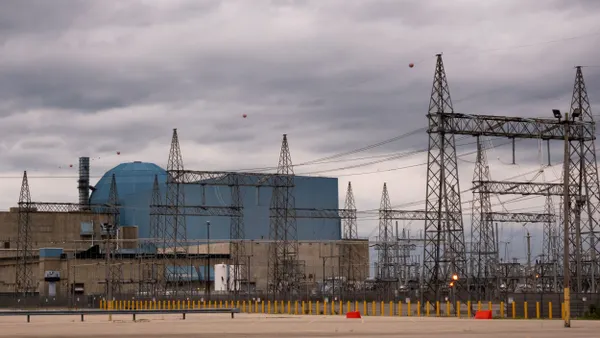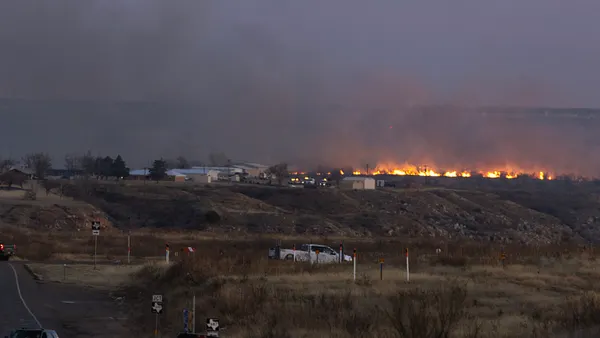Update: June 26, 2020: PG&E announced June 26 that it has priced the public offering of 423,372,629 shares of its common stock at $9.50 per share and 14,545,455 of its equity units at $100 per unit "for total net proceeds to the Corporation, before estimated offering expenses, of approximately $3.968 billion and approximately $1.186 billion, respectively." PG&E said the offerings are expected to close on July 1, subject to certain conditions, the same date it expects to emerge from Chapter 11.
Dive Brief:
- Pacific Gas & Electric (PG&E) parent company PG&E Corp. has launched public offerings of its common stock and equity units, seeking $4 billion and around $1.23 billion of gross proceeds, respectively, to partially fund its exit from bankruptcy, the company announced Monday
- The announcement comes two days after Bankruptcy Judge Dennis Montali confirmed PG&E’s Chapter 11 reorganization plan, allowing the utility to access California’s $21 billion wildfire insurance fund. PG&E expects to emerge from bankruptcy on July 1.
- Exiting bankruptcy will put PG&E on the financial footing to operate soundly, Catherine Sandoval, associate professor at the Santa Clara University School of Law and former California Public Utilities Commission (CPUC) commissioner, told Utility Dive — but the company is still exposed to the risks of catastrophic wildfires, which will need to be tackled by its new leadership.
Dive Insight:
Confirming PG&E’s plan is a step towards paying out victims of the Northern California wildfires and the utility’s other creditors, Montali wrote in a memorandum decision issued last week. Leaving tens of thousands of victims without any options instead “is not an acceptable alternative,” he said.
“This has been a very comprehensive and complex challenge for everyone, but we all set out to try to get the plan in place, and hopefully it is on the way now,” Montali said at a hearing Friday. He issued an order officially confirming the plan on Saturday.
The ruling “sets the course for PG&E’s future,” outgoing PG&E Corp. President and CEO Bill Johnson said in a statement.
“All 23,000 PG&E employees are committed to making sure our equipment never again causes another catastrophe,” he added.
The company is expecting savings of around $250 million annually due to its reorganization, it said in a June 21 press release. These savings will be incorporated into customer bills later this year.
PG&E’s path out of bankruptcy included multiple commitments to state regulators and California Gov. Gavin Newsom, D, which the utility said in a statement will “position PG&E for long-term success.” These include allowing for increased regulatory oversight, recruiting a chief risk officer and chief safety officer who will report directly to the company’s new CEO, and promising not to recover from its customers payments that were made to the victims of the Northern California fires as part of its reorganization plan.
The utility also said it has brought on board 11 new board members with “substantial expertise in diverse areas critical to the company’s work.”
It’s common for companies to formally exit bankruptcy around 30 days or less after a reorganization plan is confirmed, Sherilyn Olsen, partner at Holland & Hart, told Utility Dive, and use the time to meet various terms outlined in the plan, like raising financing.
“Sometimes in these complicated types of cases, [the terms] are tied to specific conditions similar to closing on a complicated real estate deal,” like having certain documents, people and money in place before the plan is deemed effective, she said.
Parties can appeal Montali’s decision within 14 days of his order, she added, but given that every class of impaired creditors save for one voted in favor of PG&E’s plan, “I think the likelihood of [the plan] becoming effective is probably pretty high.”
PG&E's plan received support from more than 85% of Northern California fire victims who cast votes, but a few remain concerned about its feasibility, in part due to the risk of another catastrophic wildfire.
These included 2017 Tubbs Fire survivor William Abrams, who said at a hearing in early June that the plan’s primary goal “is to ensure that entrenched investors can cash out and exit the stock…”. Montali, however, overruled those objections, pointing to the victims’ “overwhelming acceptance” of the plan.
PG&E is rolling out multiple measures to reduce the risk of wildfires in its service territory, including putting up stronger poles, transferring portions of the grid underground, implementing an "enhanced" vegetation management program as well as deploying weather stations and high-definition cameras. But the company is still exposed to wildfire risk, according to Sandoval.
“It’s looking to be a very challenging wildfire season,” and an issue she’s concerned with is that PG&E doesn’t have adequate records of its infrastructure, like the transmission line responsible for the 2018 Camp Fire, which the utility acquired in the 1930s, Sandoval said.
“[N]either the bankruptcy exit plan nor the wildfire safety plan cured those fundamental problems,” she said.














